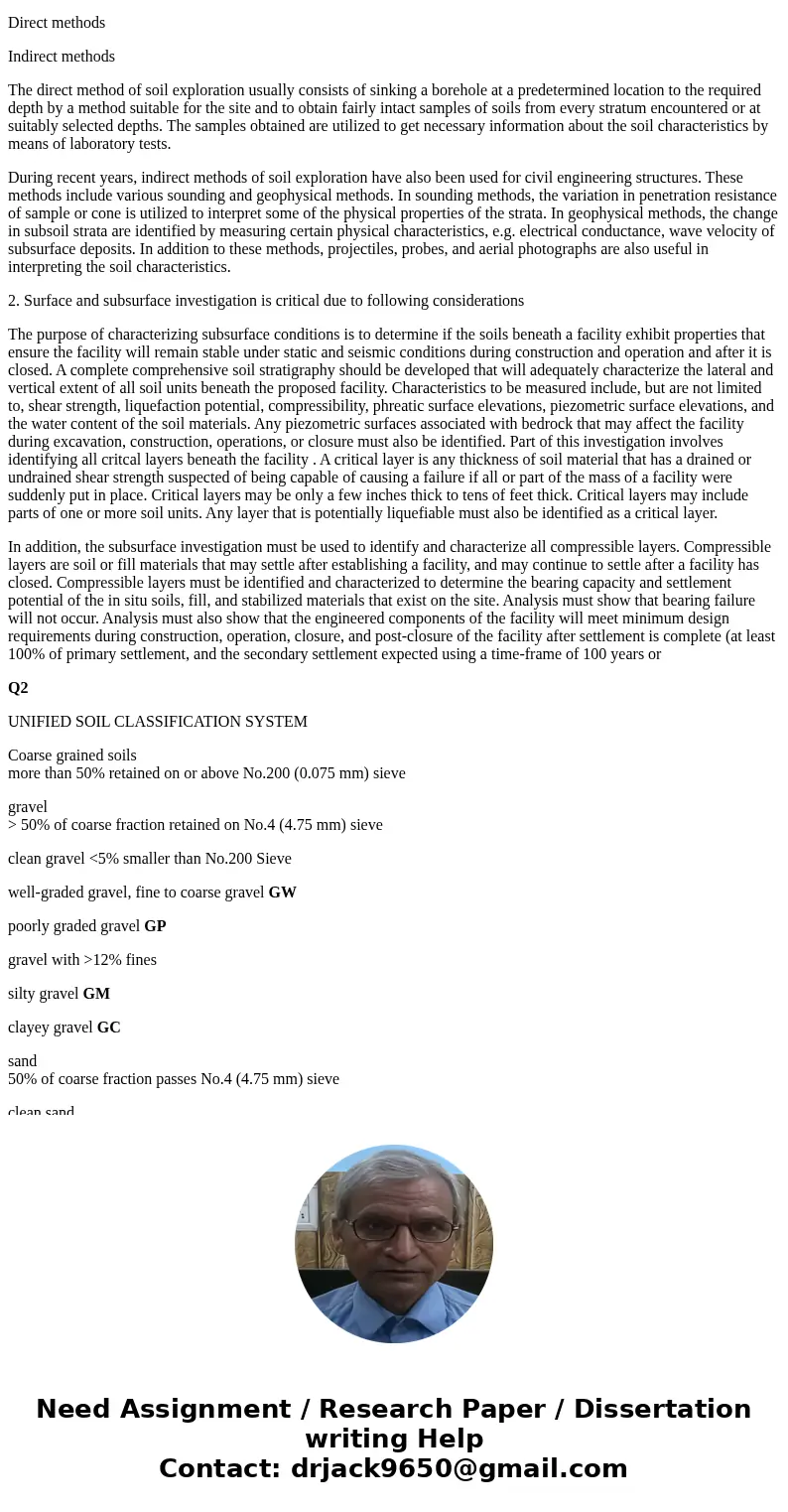eotechnical Reports Earthwork Foundations HO Tuesday January
eotechnical Reports, Earthwork, Foundations HO: Tuesday, January 24, 2017 Homework #1 DUE: Tuesday, January 31, 2017 at 12:00 PM Name: Directions for Completion and Submission: All homework assignments are to be typed on a word processor and submitted electronically via Blackboard no later than 12:00 PM on Tuesday, January 31, 2017. Be sure to show all work and to highlight your answers. You should complete this assignment individually, however you are able to work with other students, but ensure that you all turn in individual assignments. This homework is based on lectures, class discussions, course readings, and may require additional independent research. Part A: Based on lecture notes, class discussions and course readings 1. Describe the two site evaluation areas: surface investigation and subsurface investigation. (10 points) Why is each area critical? (10 points) What methods are used to complete each of these investigations? (10 points)
2. An inorganic soil has the following characteristics. Over 60% of the soil is, by weight, coarser than a no. 200 sieve, and over 50% of that fraction is larger than the no. 4 sieve. There is a significant amount of fines within the soil, and the soil is therefore very silty. How would you classify this soil? Refer to the Unified Soil Classification System chart on Slide 14 of the Earthwork lecture. (5 points)
3. State why we dewater (NOT waterproof) a site. (5 points)
4. Create a table that lists and briefly describes (one sentence each) the various supports used for open excavations. List at least five supports based on the Mehta Ch. 11 reading posted in the Assigned Readings folder on Blackboard. (10 points- 2 points per row) Supports for Open Excavations Description 1. 2. 3. 4. 5. 5. Shallow and Deep Foundations a) List and briefly describe (one sentence each) two types of shallow foundations. (4 points) b) List and briefly describe (one sentence each) two types of deep foundations. (4 points)
6. There is a proposal to build another ASU residence hall directly north of CAVC in place of where the three current parking lots are. If this proposal were accepted, would shoring be required during excavation on that site? (2 points) Why or why not? (8 points)
7. You are on a site excavating 100 cubic yards of soil. This soil needs to be removed from site, and the available trucks can carry 10 cubic yards of soil. How many trucks are needed to fully remove this soil once it is excavated? (12 points) Part B: Based on the Alpha Geotechnical Report posted on Blackboard (Alpha Geotechnical & Materials (2012) Geotechnical Subsurface Exploration Eastmark CFD Roads) Figure 1: Eastmark CDF Roads Site Plan
8. You are on the site shown in Figure 1 above. The earthwork contractor is excavating the location northeast of Ray Road and Ellsworth Road, denoted by the red X. While excavating, a member of the earthwork contractor’s team tells you she expects to hit sandy silty clay at a depth of 6 feet. a. Based on her expectation, which bore was she assuming would match the conditions at the red X? Highlight the correct answer. (1 point) i. B-2 ii. B-3 iii. B-4 b. Is it appropriate to use the bore you chose in Problem 8a for approximating the soil conditions at the location denoted by the red X? (1 point) Why or why not? (8 points) 9. For the same site at the red X, when the excavation reaches 5 feet, sandy gravel is found. a. Do you stop digging? (2 points) Why or why not? (8 points)
Solution
Site investigation or soil explorations are done for obtaining the information about subsurface conditions at the site of proposed construction. Soil exploration consists of determining the profile of the natural soil deposits at the site, taking the soil samples and determining the engineering properties of soils. It also includes in-situ testing of soils.
Subsurface Investigation
This technical area provides method and procedural guidance concerning selection, planning, executing, contracting, quality assurance/quality control, inspection, interpretation, and report preparation for subsurface explorations involving transportation applications. The subsurface characterization techniques covered includes the in situ testing, the geophysical testing, and the laboratory test selection used to establish appropriate soil and rock design and construction parameters.
Methods of site exploration
General The various types of site investigation are: Open excavation
Boring Subsurface Sounding
Geophysical Methods
These available methods of exploration can be broadly classified into two categories:
Direct methods
Indirect methods
The direct method of soil exploration usually consists of sinking a borehole at a predetermined location to the required depth by a method suitable for the site and to obtain fairly intact samples of soils from every stratum encountered or at suitably selected depths. The samples obtained are utilized to get necessary information about the soil characteristics by means of laboratory tests.
During recent years, indirect methods of soil exploration have also been used for civil engineering structures. These methods include various sounding and geophysical methods. In sounding methods, the variation in penetration resistance of sample or cone is utilized to interpret some of the physical properties of the strata. In geophysical methods, the change in subsoil strata are identified by measuring certain physical characteristics, e.g. electrical conductance, wave velocity of subsurface deposits. In addition to these methods, projectiles, probes, and aerial photographs are also useful in interpreting the soil characteristics.
2. Surface and subsurface investigation is critical due to following considerations
The purpose of characterizing subsurface conditions is to determine if the soils beneath a facility exhibit properties that ensure the facility will remain stable under static and seismic conditions during construction and operation and after it is closed. A complete comprehensive soil stratigraphy should be developed that will adequately characterize the lateral and vertical extent of all soil units beneath the proposed facility. Characteristics to be measured include, but are not limited to, shear strength, liquefaction potential, compressibility, phreatic surface elevations, piezometric surface elevations, and the water content of the soil materials. Any piezometric surfaces associated with bedrock that may affect the facility during excavation, construction, operations, or closure must also be identified. Part of this investigation involves identifying all critcal layers beneath the facility . A critical layer is any thickness of soil material that has a drained or undrained shear strength suspected of being capable of causing a failure if all or part of the mass of a facility were suddenly put in place. Critical layers may be only a few inches thick to tens of feet thick. Critical layers may include parts of one or more soil units. Any layer that is potentially liquefiable must also be identified as a critical layer.
In addition, the subsurface investigation must be used to identify and characterize all compressible layers. Compressible layers are soil or fill materials that may settle after establishing a facility, and may continue to settle after a facility has closed. Compressible layers must be identified and characterized to determine the bearing capacity and settlement potential of the in situ soils, fill, and stabilized materials that exist on the site. Analysis must show that bearing failure will not occur. Analysis must also show that the engineered components of the facility will meet minimum design requirements during construction, operation, closure, and post-closure of the facility after settlement is complete (at least 100% of primary settlement, and the secondary settlement expected using a time-frame of 100 years or
Q2
UNIFIED SOIL CLASSIFICATION SYSTEM
Coarse grained soils
more than 50% retained on or above No.200 (0.075 mm) sieve
gravel
> 50% of coarse fraction retained on No.4 (4.75 mm) sieve
clean gravel <5% smaller than No.200 Sieve
well-graded gravel, fine to coarse gravel GW
poorly graded gravel GP
gravel with >12% fines
silty gravel GM
clayey gravel GC
sand
50% of coarse fraction passes No.4 (4.75 mm) sieve
clean sand
well-graded sand, fine to coarse sand SW
poorly graded sand SP
sand with >12% fines
silty sand SM
clayey sand SC
FROM the data it can be seen soil is coarsed soil ( coarser than a no. 200 sieve, and over 50% of that fraction is larger than the no. 4 sieve) so it is gravel and now it is having significant fines so it can be classified as silty Gravel as depicted from the table
Q3.
Construction dewatering are terms used to portray the act of removing groundwater or surface water from a construction site. Usually the dewatering process is done by pumping or evaporation and is generally done prior to excavation for footings or to lower water table that might be causing troubles during excavations. Dewatering can also refer to the process of removing water from soil by wet classification.
Why Dewatering?
Construction dewatering is employed on nearly all construction sites owing to amassed water in trenches and excavations or in places with insufficient slope or high water table. In construction projects, this water should be removed to keep working as planned or to offer a safe workplace. Generally, builders are likely to use water pumps to dewater these regions, but if they are not paying attention to the place where water is discharged, erosion and other problems may happen. It is vital to follow best management practices when water is being pumped to lakes, wetlands or directly to storm sewer inlets.
| Coarse grained soils | gravel | clean gravel <5% smaller than No.200 Sieve | well-graded gravel, fine to coarse gravel GW |
| poorly graded gravel GP | |||
| gravel with >12% fines | silty gravel GM | ||
| clayey gravel GC | |||
| sand | clean sand | well-graded sand, fine to coarse sand SW | |
| poorly graded sand SP | |||
| sand with >12% fines | silty sand SM | ||
| clayey sand SC |



 Homework Sourse
Homework Sourse